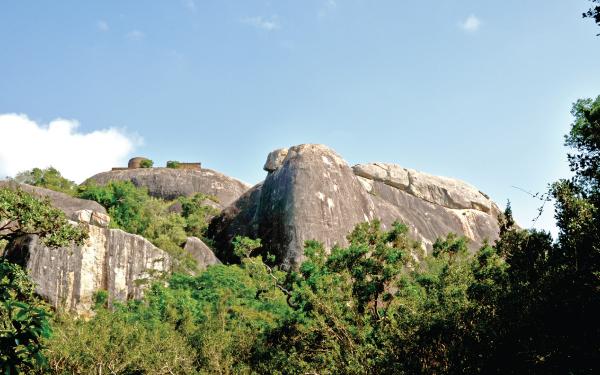
We spotted the isolated Kudumbigala rock in the distance, before we entered the gravel road which led to the Kumana National Park. 
Kudumbigala lies majestically on top of a rocky outcrop in the Yala East National Park better known as Kumana, 11 kilometres away from Panama.
Kudumbigala Sanctuary
Today, it is known as the Kumana-Kudumbigala Sanctuary. There is a shrub jungle covering thousands of acres. No proper road runs through it. Kudumbigala is a sacred Buddhist hermitage frequented by elephants, leopards and bears, but none of these fearsome animals trouble the monastic bhikkhus who meditate in the natural rock caves in the forest.
When you climb to the top of the rock, you can see wonderful scenery such as the Kumana National Park, the Bagura lagoon and the East coast that is a sight to behold.
 |
| The main stupa of the Kudumbigala forest hermitage |
Drip-ledged caves
Perhaps, this may be one reason, why monastic bhikkhus of a bygone era, have chosen this quiet place to reflect on the eternal verities. This sylvan Buddhist hermitage comprises over 200 natural drip-ledged caves, which are used by meditating bhikkhus as their abodes in the jungle.
The inscriptions in Brahmi script and other ruined structures in the recently discovered cave in the hermitage, Maha Sudharshan a Lena, indicate that Kudumbigala was established as a forest hermitage in the pre-Christian era. A stone inscription at the hermitage has it that the Maha Sudharshana Lena was built and presented to the monastic bhikkhus by NandimitraYodaya (giant), one of King Dutugemunu’s Dasa MahaYodhayas.
Kudumbigala was first established as a refuge for meditative bhikkhus during the time of King Devanampiyatissa. In recent times, it was re-discovered in 1954 by Ven. Thambugala Anandasiri Thera and an Upasaka named Maithree.
They made Kudumbigala their home and initiated its rehabilitation.
When they came to Kudumbigala, it had been a dangerous place for people, as it was frequented by wild animals. However, they have never harassed either Anandasiri Thera or Maithree Upasaka.
In 1994, darkness enveloped Kudumbigala. LTTE terrorists had hacked to death 17 civilians in Panama. Kudumbigala was abandoned. Some of the meditative bhikkhus moved to the nearby Tharulengala hermitage, a branch of Kudumbigala that lies in Hulan Nuge. The only visitor to Kudumbigala was Ven. Sivuralumulle Dhammasiri Thera, who as the chief prelate, made it a point to go there every now and again.
Today, there is no human habitation around this hermitage. Kudumbigala stands towering in silent splendour.
 |
| The Maha Sudharshana Lena |
When we visited the place in 2002, we couldn’t even find the way to the chief bhikkhu’s adobe. After a laborious process, we reached the top of the rock and met the chief bhikkhu, Ven. Sivralumulle Dhammasiri Thera, in his cave, which was scattered with skulls and bones of wild animals. The Thera’s seat was made of the skull of an elephant.
Treasure hunters
During its desertion, Kudumbigala was once a haven for treasure hunters. All the stupas had been destroyed in search of treasure. Even today, ‘peace’ has not been able to safeguard Kudumbigala and its environs. Treasure hunters keep looking for abandoned temples, wild animals are being hunted by poachers, and smugglers are destroying precious jungles for timber.
Today, the Kudumbigala forest hermitage is a popular Buddhist hermitage in the East. A large number of devotees from distant places offer dana or alms to meditative bhikkhus who dwell in the natural caves.
